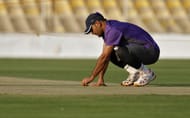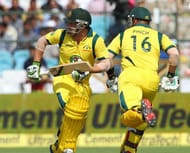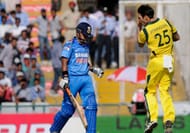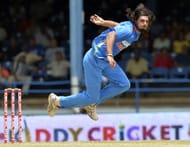Only T20I: Australia 201/7; India 202/4 - India won by 6 wickets
1st ODI: Australia 304/8; India 232 – Australia won by 72 runs
2nd ODI: Australia 359/5; India 362/1 – India won by 9 wickets
3rd ODI: India 303/9; Australia 304/6 – Australia won by 4 wickets
The India – Australia limited overs series is well and truly underway and from the above scores, it’s been a complete run feast. The batsman has made merry of the brilliant batting conditions while the bowlers have had quite a nightmare (not alluding to Ishant Sharma here).
India won the lone T20 while Australia leads the ODI series 2-1. It’s been a much closer series than one predicted. After a forgetful Ashes, everyone expected the Australians to roll over like nine pins against a very strong Indian side but to the dismay of the experts, the George Bailey-led Aussie team have gone shoulder-to-shoulder against the Indians which has raised quite a few eyebrows with their performances.
There are a few factors that have clicked in favour of the Australians though. Firstly, their ODI team is starkly different from that of their Test outfit and it has worked well for them because most of the members of this side weren’t a part of the Ashes humiliation.
In fact, this team actually won the ODI series in England that followed the Ashes and is currently ranked number two behind India in the ICC ODI ratings. So, it’s hardly a surprise to see them doing so well against India.
The Aussies may have the lead in the seven match series but to write off the Indians will be a huge mistake. Not only they are playing at home, but also they are the current chart toppers of the ICC ODI ratings.
So as the battle between the two top ranked sides moves to Ranchi, let’s take a look at the five factors that will impact the outcome of the game.
The Toss
Although, the toss doesn’t make much difference on such placid tracks, this series the toss has played quite an important role. With the games starting at 1:30 in the afternoon, there’s hardly any help for the faster men but after the sunset, under the lights, the conditions tend to change.
The toss also affects the team compositions and their way of approaching the game. India is a batting heavy team and always looks to chase. Their batting is their strength and their batsmen, right now, feel that they are capable of chasing any target. Moreover, India prefers chasing to veil the weaknesses of their wafer-thin bowling attack.
And that’s where Australia changed the game in the last ODI. George Bailey won the toss and elected to field first letting India set a target so that Australia can attack India’s weakest link. Although India did a good job by reaching a 300 plus score, their bowling performance revealed their vulnerability when it comes to defending.
Another factor that the toss affects is the dew. With November setting in, the dew factor is bound to compel the captains to have a bowl first. Under lights, the dew adds a sheen on the wicket and stroke making becomes a lot easier. The wet outfield also doesn’t help because the spinners struggle to grip a moist seam.
Verdict – Win toss, bowl first
The Wicket
The talking point of the series has been the wickets. From Rajkot to Mohali, the wickets have heavily favoured the batsmen and the bowlers have struggled to make any impression at all. Generally this isn’t the case. India normally prepares slow turners that brings India’s part timers into play and chokes the opposition.
However, it hasn’t been the same this time round. This is the beginning of the cricket season in India and the wickets have had even bounce, good carry and has been excellent for stroke play.
Ranchi too promises to be a batting paradise. Although, the wickets at the JSCA international stadium behaved weirdly during the IPL and drew quite a flack, the Champions League T20 saw a complete makeover. The IPL game saw both Kolkata Knight Riders and Royal Challengers Bangalore crumble but the Champions League T20 saw a score of 185 being chased down.
So, as far as the batsmen are concerned, good news again but if you are a bowler, well.
Verdict – Plant that front foot and hit through the line.
Opening partnerships
The best aspect of both teams has been their openers and the starts they have provided. The Australian pair of Aaron Finch and Phil Hughes has been nothing short of sensational in this tour. They have complimented each other brilliantly and has paced their partnership beautifully to set up a platform for Australia to take off.
Finch has been in the form of his life and scoring seems easy for him. He is not only scoring fast but he’s scoring big. That’s been a huge change in Finch this season – he’s no more making those attractive twenties anymore, he raking up the solid seventies and eighties. He’s ready to wait for the bad ball and shifts gears only when he’s completely set.
Hughes too, has found a place for himself. After a forgettable tour of India last winter, Hughes has finally started to deliver the goods. Although he doesn’t look as solid as Finch, yet his performances has impacted Australia’s success.
For India, the partnership of Shikhar Dhawan and Rohit Sharma has shut the door for Virender Sehwag and Gautam Gambhir, at least for the time being. Dhawan continues to be the phenomena that he is while the penny has finally dropped for Rohit Sharma.
If Dhawan has continued his good form, Sharma has found his correct place in this batting line-up. Both are good players of the new ball and don’t look hurried by the extra pace of the Australian bowlers.
Verdict: Another good partnership from the openers of both teams
Australia’s short ball strategy
It’s not a good feeling when a five and a half ounce leather ball zooms past your nose or tickles your rib cage. And when that ball is hurled at 90 miles per hour – the discomfort increases to another level. The love story between Indian batsmen and short pitch deliveries has been a complicated one since time immemorial.
The Indian batsmen has always struggled to handle a delivery that’s above their waist and foreign teams has often used it against them as a very potent strategy. It’s been the same this series as well.
After a receiving a pasting from the Indian batsmen in the T20 game at Rajkot, the Aussies switched to the age old “bowl it at the ribcage” strategy. It backfired at Jaipur, where the ball sat up at a nice height, but it bore fruit in both Pune and Mohali.
Although, Virat Kohli, Rohit Sharma and MS Dhoni doesn’t have much hassles with handling the short pitch stuff, the left handers in the line-up were exposed by Mitchell Johnson. He bowled with fire and hit the deck hard to extract some awkward bounce that saw Suresh Raina, Yuvraj Singh and Ravindra Jadeja perish. However, if the Australians overdo it, there’s a big chance of them being carted for easy runs.
This is a very strong Indian batting outfit but it surely can be rattled. Will that happen again in Ranchi?
Verdict: Watch out for Mitch Johnson
India’s death bowling
Death bowling – biggest worry for the Indians and it has been for some time. In the past, Dhoni has tried to shield his bowlers by offering the “inexperience” excuse but now even the Indian captain seems to be running out of patience.
The duo of Bhuvneshwar Kumar and Vinay Kumar has been at best ordinary and Ishant Sharma, well, let’s not even go in there. Jadeja and Yuvraj has done a fair job in the middle overs but Ashwin’s lack of wickets has been another major worry for MS Dhoni.
India again would be looking to bowl first to shield their bowlers but if Australia wins the toss, they would be more than eager to test the Indian bowling again.
Verdict: Can the Indian bowlers come back with an improved performance? Not time but the last ten over will tell…
Brand-new app in a brand-new avatar! Download Cric Rocket for fast cricket scores, rocket flicks, super notifications and much more!




